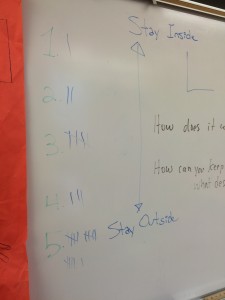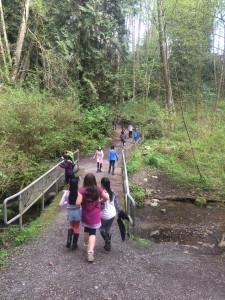I believe students learn best when they feel safe in their classroom environment. To ensure this, I structure my teachings at the beginning of the year to build strong relationships. I make sure I personally talk to each student at the beginning of the day about how they are feeling and what is happening in their lives outside of school. A sense of belonging is important for each student to have because it works towards their overall feeling of safety. I encourage this by giving them partial authority on classroom rules. If there are rules that cannot be changed, and have been enforced for a reason, then I communicate this with honesty to my students. I am always open and forthright with my expectations so my students do not feel tricked. In order to make each student feel that their work is valued and carefully looked at, I deliver my feedback face-to-face and confidentially during hours that are outside of my teaching blocks.
Building relationships with every student is important to me because I’m able to see their interests and therefore shape my lessons accordingly. My lessons are catered to the needs and interests of my students by providing them with different classroom environments. I
use a variety of hands-on activities, visual posters, media, colouring utensils, group activities, and indoor and outdoor locations to keep students engaged and excited to learn. Engagement leads to curiosity if the lessons are structured properly, and curiosity is the base for a lasting future of self-directed learning. We cannot force our students to learn, so that is why I teach students to teach themselves. I use self-directed learning (Inquiry-based) learning in my classroom every day, and I usually prompt it by asking questions. I leave material on the students desks before class, so when they come to class from home or recess, they spend the first couple of minutes chatting with one-another about what we could be doing. I let the curiosity build before announcing what we’re doing. Many times I will start the learner engagement by pretending I am not sure of something, whether it is an object, a word, or a concept, I turn to them as the knowledgeable ones.
A classroom environment where students care for one-another is essential, because we rely on one-another for many things we do. Compassion is one of the qualities I foster in the classroom, and I do so by first having st udents understand their classmate’s personal backgrounds. At the beginning of the year I include ice-breaker activities, group talks, family painting / portrait sharing, and many other similar activities for students to share their interests and stories during class time. Compassion is built when students are able to find commonalities with their peers, and these games provide ample opportunity for students to find common ground with one-another. Compassion is brought forth when a student finds their peers struggling, so I build mock situations into my lessons with outdoor activities. I have students work with one-another to overcome obstacles like log balancing, and in doing-so they form tight bonds, enabling them to beat real-world difficulties together. Compassion is one aspect of my caring classroom environment, and action is the other. Action is crucial to a positive, caring environment because if students are not equipped with action then they may feel strongly for somebody, but may never move forward towards helping them. I bring action into my classroom through a variety of ways, mainly in little steps at a time. Outdoor education is where I include a lot of my action-based teachings because students are easily able to see how interdependent we are on the environment, and how fragile it is. I do activities like salmon spawning, where we raise salmon eggs and release them once they’ve hatched. I have my
students see the effects of plastic and garbage on our environment by taking them to parks and contrasting it with a trip to the dump. Afterward, we spend some time each week collecting garbage around the school grounds. Steps of action like these are conducive to a caring classroom environment because if one student is finding they are being bullied, hopefully the compassionate and action-based activities can help other peers step forward and stand up for them.
I hope that all of my teaching practices work towards limiting behaviours such as bullying, however I am aware some of these attitudes still exist. In order to reduce and ideally eliminate challenging behaviors, I start by looking for early signs. If a student is showing a different behavior than usual, such as segregating themselves from their peers, I talk to them about it personally. This is partially the reason I build strong relationships with my students, because it allows them to respond openly about what is happening. Other behavioral issues in class, like disagreements between students can be handled in a similar way. Meeting personally with the students involved, and working collaboratively to come up with a solution is a my approach to disagreements


